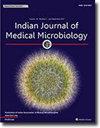吸虫病:印度东北部持续存在的公共卫生问题
IF 1.4
4区 医学
Q4 IMMUNOLOGY
引用次数: 0
摘要
目的吸虫病属吸虫是食源性人畜共患病(即吸虫病)的来源。自20世纪80年代初以来,该病已被确定为在印度东北部暴发,由于类似的临床和放射检查结果,经常被诊断为结核病。本研究旨在更新近年来本病的临床放射学特征和地理分布。方法回顾性收集和分析2011年至2023年在曼尼普尔邦3家医疗机构就诊的37例肺吸虫病疑似病例的资料。检索和分析临床资料、饮食习惯和地理位置史以及实验室数据。在微生物实验室,对痰液和胸膜液进行微生物学检查和血清学检测,采用免疫层析点印迹快速试验(DIGFA)。结果37例病例中,32例确诊为肺吸虫病。临床表现为胸腔积液(11例)、脑伴肺积液(1例)、皮肤积液(1例)、肺积液(19例)。所有患者均有食用螃蟹史。小儿13例,占40.6%。报告时,22例(68.75%)临床怀疑为结核,其中16例(50%)已接受抗结核药物治疗。口服吡喹酮25 mg/kg体重,每日3次。结论该疾病仍然是曼尼普尔的一个公共卫生问题,新流行疫源地的发现证明了这一点。它继续被误诊为结核病,并被不当管理。在嗜酸性粒细胞计数高的患者中,需要更多的意识和政策来检查AFB涂片阴性痰样本是否患有肺吸虫病。本文章由计算机程序翻译,如有差异,请以英文原文为准。
Paragonimiasis: A continuing public health problem in northeast India
Purpose
Trematode species belonging to the genus Paragonimus are the source of the food-borne parasitic zoonosis known as paragonimiasis. The disease has been identified as an outbreak in northeastern India since the early 1980s and is frequently diagnosed as tuberculosis because of similar clinical and radiological findings. This study is an attempt to update the clinic-radiological features and geographical distribution of the disease in recent times.
Methods
We retrospectively collected and analysed the data of 37 paragonimiasis suspected cases attending three healthcare facilities in Manipur from 2011 to 2023. Clinical data, history of food habits and geographical location, and laboratory data were retrieved and analysed. In the microbiology laboratory, sputum and pleural fluid examination were subjected to microbiological examination and serological testing using DIGFA, an immunochromatographic dot blot rapid test.
Results
Out of 37 cases, 32 cases were confirmed to be paragonimiasis. Clinical manifestations were pleural effusion (n = 11), cerebral with pulmonary (n = 1), cutaneous (n = 1), and pulmonary (n = 19). All patients had a history of consuming crabs. Thirteen cases were pediatric patients, representing 40.6 %. At the time of presentation, 22 cases (68.75 %) were clinically suspected to be TB, and 16 (50 %) of them were already receiving anti-TB drugs. The patients were treated with oral praziquantel, 25 mg/kg of body weight, three times a day.
Conclusions
The disease remains a public health concern in Manipur, as evidenced by the identification of new endemic foci. It continues to be misdiagnosed and mismanaged as tuberculosis. More awareness and a policy to examine AFB smear-negative sputum samples for paragonimiasis in patients with high eosinophil count is the need of the hour.
求助全文
通过发布文献求助,成功后即可免费获取论文全文。
去求助
来源期刊

Indian Journal of Medical Microbiology
IMMUNOLOGY-
CiteScore
2.20
自引率
0.00%
发文量
154
审稿时长
73 days
期刊介绍:
Manuscripts of high standard in the form of original research, multicentric studies, meta analysis, are accepted. Current reports can be submitted as brief communications. Case reports must include review of current literature, clinical details, outcome and follow up. Letters to the editor must be a comment on or pertain to a manuscript already published in the IJMM or in relation to preliminary communication of a larger study.
Review articles, Special Articles or Guest Editorials are accepted on invitation.
 求助内容:
求助内容: 应助结果提醒方式:
应助结果提醒方式:


